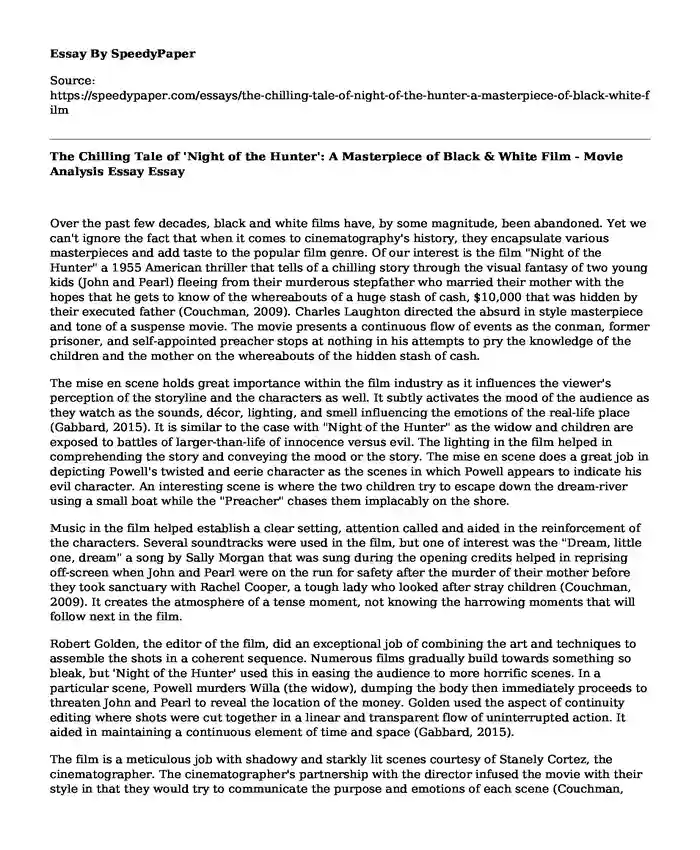
| Type of paper: | Movie review |
| Categories: | Entertainment Movie Art |
| Pages: | 3 |
| Wordcount: | 808 words |
Over the past few decades, black and white films have, by some magnitude, been abandoned. Yet we can't ignore the fact that when it comes to cinematography's history, they encapsulate various masterpieces and add taste to the popular film genre. Of our interest is the film "Night of the Hunter" a 1955 American thriller that tells of a chilling story through the visual fantasy of two young kids (John and Pearl) fleeing from their murderous stepfather who married their mother with the hopes that he gets to know of the whereabouts of a huge stash of cash, $10,000 that was hidden by their executed father (Couchman, 2009). Charles Laughton directed the absurd in style masterpiece and tone of a suspense movie. The movie presents a continuous flow of events as the conman, former prisoner, and self-appointed preacher stops at nothing in his attempts to pry the knowledge of the children and the mother on the whereabouts of the hidden stash of cash.
The mise en scene holds great importance within the film industry as it influences the viewer's perception of the storyline and the characters as well. It subtly activates the mood of the audience as they watch as the sounds, décor, lighting, and smell influencing the emotions of the real-life place (Gabbard, 2015). It is similar to the case with "Night of the Hunter" as the widow and children are exposed to battles of larger-than-life of innocence versus evil. The lighting in the film helped in comprehending the story and conveying the mood or the story. The mise en scene does a great job in depicting Powell's twisted and eerie character as the scenes in which Powell appears to indicate his evil character. An interesting scene is where the two children try to escape down the dream-river using a small boat while the "Preacher" chases them implacably on the shore.
Music in the film helped establish a clear setting, attention called and aided in the reinforcement of the characters. Several soundtracks were used in the film, but one of interest was the "Dream, little one, dream" a song by Sally Morgan that was sung during the opening credits helped in reprising off-screen when John and Pearl were on the run for safety after the murder of their mother before they took sanctuary with Rachel Cooper, a tough lady who looked after stray children (Couchman, 2009). It creates the atmosphere of a tense moment, not knowing the harrowing moments that will follow next in the film.
Robert Golden, the editor of the film, did an exceptional job of combining the art and techniques to assemble the shots in a coherent sequence. Numerous films gradually build towards something so bleak, but 'Night of the Hunter' used this in easing the audience to more horrific scenes. In a particular scene, Powell murders Willa (the widow), dumping the body then immediately proceeds to threaten John and Pearl to reveal the location of the money. Golden used the aspect of continuity editing where shots were cut together in a linear and transparent flow of uninterrupted action. It aided in maintaining a continuous element of time and space (Gabbard, 2015).
The film is a meticulous job with shadowy and starkly lit scenes courtesy of Stanely Cortez, the cinematographer. The cinematographer's partnership with the director infused the movie with their style in that they would try to communicate the purpose and emotions of each scene (Couchman, 2009). Most shots of the film are elegant and cautiously composed. One good aspect of Deep focus in the movie was when Powell appeared in a distance when the kids were waiting for the savior at Ms. Cooper's house. The camera's movement in the deep focus provides the audience with the opportunity to contemplate what was happening on and off the screen.
It is with no doubt that in glamour cinematography, black and white wins it all. In today's era, directors prefer black and white in making a political and aesthetic point. Other films are also shot in black and white as a tribute to the earlier cinema genres before colored films came into play (Gabbard, 2015). It is also a favorable medium in evoking a sense of the past. "Night of the Hunter" is breathtakingly cinematic, just as discussed in the few graphic scenes in this paper, providing a firm basis that black and white films can give stunning performances. The views are meticulously polished, with the stacked building of evil and inhumanity of the serial killer wolf hiding in sheep's clothing of "Preacher."
References
Couchman, J. (2009). The Night of the Hunter: A Biography of a Film. Northwestern University Press. ISBN 978-0-810-12542-1.
Gabbard, K. (2015). “They Always Get the Best of You Somehow”: Preston Sturges in Black and White. Refocus: The Films of Preston Sturges. doi:10.3366/edinburgh/9781474406550.003.0007.
Cite this page
The Chilling Tale of 'Night of the Hunter': A Masterpiece of Black & White Film - Movie Analysis Essay. (2023, Oct 29). Retrieved from https://speedypaper.com/essays/the-chilling-tale-of-night-of-the-hunter-a-masterpiece-of-black-white-film
Request Removal
If you are the original author of this essay and no longer wish to have it published on the SpeedyPaper website, please click below to request its removal:
- Free Essay on Public Health Campaign on Social Media
- Essay Example with the Movie Review on Hobart Shakespearean
- Wearable Computing and Ubiquitous Computing Augmented Fashion, Smart Textiles and IoT Augmenting Humans
- Paper Example. Understanding Social Media
- Raising Bertie: Movie Analysis Essay
- Free Essay - Peanut Butter Falcon
- Exploring Janis Joplin: A Free Essay on the Life and Music of a Cultural Icon
Popular categories




